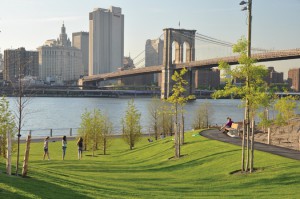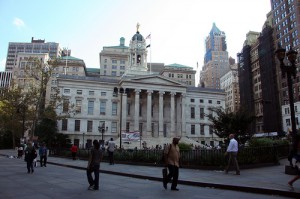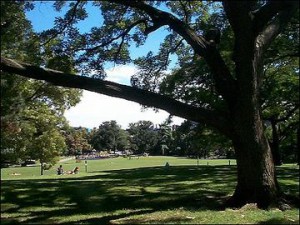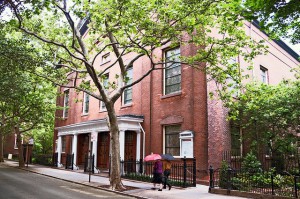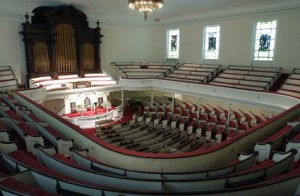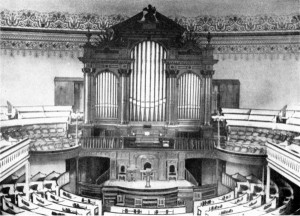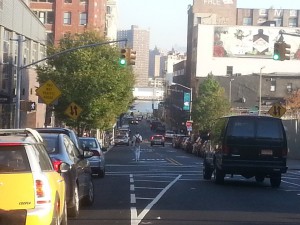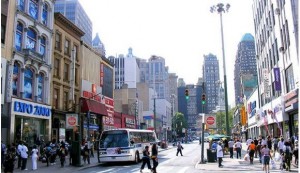
My high school teacher always said the life in city universities is like the high school; you go to school and go back home. Now, this became part of my life; I never explore the neighborhood near the City College of Technology, because I think Downtown Brooklyn just is a college town, since I saw many school on my way to CityTech. However, everything had changed after I crossed the line, and found the Fulton Mall, the center of the Downtown Brooklyn. Fulton Street not just a street full of department stores, its heavy value proves the changing of the New York and also shows how New York overlapping.
How to arrive the Fulton Street? Starting at the entrance of General building from our school, turn left and walk straight down to the Fulton Street, approximately four blocks away; when you passed the Willoughby Plaza, make a left turn to the Fulton Mall. That is where I begin my adventure, the central area of the street.
When I first got there, the first thing I capture in my eyes is people. Even that was the weekday; people were still walking through the street, and shopping in retail stores unstoppably. I like frame a photographs from the view of my eyes, as I walking on the street, I take new things and interest things in my photographs
My eyes follow the walking people and I start to focus on the department stores on the Fulton Street. There were some famous brand chain stores I knew very well, such as Modell, Starbucks and Gaps, etc. however, there was also many unknown local retail stores that I never heard of, most of them are the clothes store, and they were selling very unique and stylish clothes, very different with the brand store. I suddenly understand why people concentrate at here; unlike all brand stores in Soho, New York, Fulton Mall gives people more options, more creative products and ideas, always impress the customers.
I kept walking and stopped on the corner of the street, when I waiting the red light turn white, I look up, and I found some interesting things about downtown Brooklyn’s building. The buildings along the Fulton Street are shorter than the buildings around the Fulton Street. I guess because the buildings on the Fulton Street were older than the buildings around the street, since they are not replaceable, people kept moving in and joined the economy of Brooklyn Fulton Street, the street keep its look for the businesses, instead changing for the people to live in.
I chose this place for the project because I like the atmosphere on Fulton Street, it is very lively, and make me want to shop. When I explore the Downtown Brooklyn, I lost my self at there. I almost give up and try to find station on Jay Street and go home, then, I found the Fulton Street. I still remember how impressive it is when I saw that shoppers rushing on the street carried shopping bags on their both hands. I always thinks Brooklyn is quiet neighborhood, boring and historical; however, Fulton street is totally different; it is fashionable, and lively. This is the new Brooklyn I never knew; just like Mr. Self said, “it’s all I can do to keep myself from being isolated all the time” (McGrath). New York is the greatest city with many new, fresh, and interesting things around, it always freshened up people. Therefore, we should not isolate ourselves in certain places; and to enjoy this “munificent gift”, get to know about it.
From Whitehead’s “City Limited”, it said, “You didn’t know that each time you passed the threshold you were saying goodbye” (Whitehead).The changing along the Fulton Mall is similar to that Chinese restaurant; someday, this store opens, someday, that store closed. People never know what happen tomorrow especially the fashion business. After a month, when you come back and shop in Fulton Street, you will find out your “old friend” was gone and a “new friend” came. Like the author Whitehead said you never know when to say goodbye to your New York. From the past to present, we can see that Fulton Street keep changing and we still cannot predict what it would be in the future.
“Our old building still stand because we saw them, moved in and out of their long shadows…They are part of city we carry around. It is hard to imagine that something will take their place” (Whitehead). It is disappointed when you coming for something and after you get there, it is gone. And you can only put the old memories put inside your heart. Thus, you have to treasure every time you meet it. For the people, Fulton Street might just a street for shoppers to shop, for customers to eat, and a nice place for people to relax and enjoy the simple pleasure. However, from the past to present, along on the Fulton Street, especially the Fulton mall area, the street changes as the time move on. We always come back because Fulton Street is part of city that we carry, that old place the full of many happy memories. The value of Fulton Street is much heavy than its actual weight.
After visiting along the Fulton Street, I want to know more about the history of this amazing street, when it developed? Why it developed at the center of Downtown Brooklyn.
Downtown Brooklyn is a cluster of extraordinary neighborhood, you never know if you not explore it. Like Fulton Street, one of the busiest shopping districts in Brooklyn, it just a simple neighborhood, but it show the New York overlapping, from the past to present, from National to local department stores. By compare and contract every detail on that street, I was more understand the author of “City Limited”, your own New York is create by yourself, you never knew a New York by hearing other people said.
Work Cited
McGrath, Charles, “A Literary Visitor Strolls in From the Airport.” The New York Times 6 December, 2006. Web. 23 September, 2013.
Whitehead, Colson, “City Limits.” The Colossus of New York: A City in Thirteen Parts. New York: random House, 2004.1-12.

